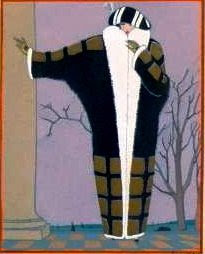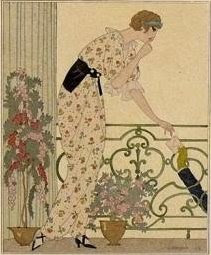Georges Lepape, studied at the Ecole des Arts D?coratifs, Paris, and the ateliers of Humbert and Cormon. In 1911 illustrated Les Choses de Paul Poiret and the following year programmes for the Ballet Russe . Innumerable magazines covers and fashion plates for La Gazette du Bon Ton and Vogue.
In 1911, Poiret again published a brochure of his designs, this time created by another young artist, Georges Lepape, who had been trained in the atelier run by Fernand Cormon, where Toulouse-Lautrec, Van Gogh, S?rusier, Matisse, and Picabia had all studied. Les Choses de Paul Poiret, vues par Georges Lepape appeared in a larger edition: one thousand copies were printed (Paris: 1911). Lepape, too, had absorbed the lessons of bright color taught by the Ballet Russes, and his pochoir prints of Poiret's still high-waisted fashions in this brochure and later in the Gazette du Bon Ton used line drawings with large areas of blues, greens, reds, pinks, and yellows.
Wednesday, December 3, 2008
BARBIER
George Barbier (1882 - 1932) was one of the great French illustrators of the early 20th century. Born in Nantes France on October 10, 1882, Barbier was 29 years old when he mounted his first exhibition in 1911 and was subsequently swept to the forefront of his profession with commissions to design theatre and ballet costumes, to illustrate books, and to produce haute couture fashion illustrations.
For the next 20 years Barbier led a group from the Ecole des Beaux Arts who were nicknamed by Vogue as "The Knights of the Bracelet" - a tribute to their fashionable and flamboyant mannerisms and style of dress. Included in this ?lite circle were Bernard Boutet de Monvel, Pierre Brissaud, Paul Iribe, Georges Lepape and Charles Martin. During his career Barbier also turned his hand to jewellery, glass and wallpaper design, wrote essays and many articles for the prestigious Gazette du bon ton.
In the mid 1920s he worked with Ert? to design sets and costumes for the Folies Berg?re and in 1929 he wrote the introduction for Ert?'s acclaimed exhibition and achieved mainstream popularity through his regular appearances in L'Illustration magazine.
Barbier died in 1932 at the very pinnacle of his success.
For the next 20 years Barbier led a group from the Ecole des Beaux Arts who were nicknamed by Vogue as "The Knights of the Bracelet" - a tribute to their fashionable and flamboyant mannerisms and style of dress. Included in this ?lite circle were Bernard Boutet de Monvel, Pierre Brissaud, Paul Iribe, Georges Lepape and Charles Martin. During his career Barbier also turned his hand to jewellery, glass and wallpaper design, wrote essays and many articles for the prestigious Gazette du bon ton.
In the mid 1920s he worked with Ert? to design sets and costumes for the Folies Berg?re and in 1929 he wrote the introduction for Ert?'s acclaimed exhibition and achieved mainstream popularity through his regular appearances in L'Illustration magazine.
Barbier died in 1932 at the very pinnacle of his success.
Subscribe to:
Posts (Atom)




























